Resident Evil Village: 7 Was Not a Fluke
By lapsariangiraff 40 Comments
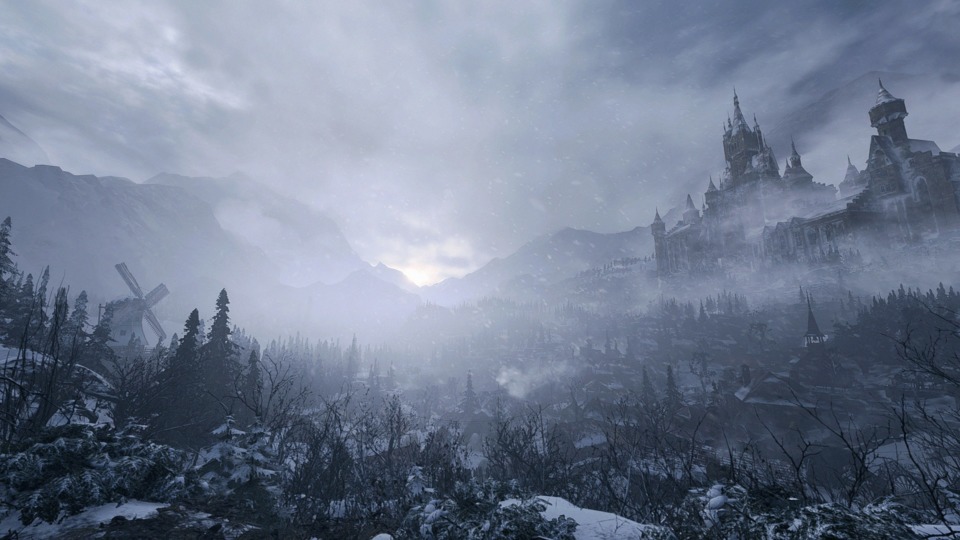
Can we take a moment and admire the total renaissance Resident Evil is experiencing right now?
From about 2012 (Resident Evil 6) to 2016, the series felt, for all intents and purposes, dead. The action slant that had begun with the brilliant Resident Evil 4—its innovative over the shoulder camera (something something Killswitch did it first something) combined with its taut pacing creating a tense experience that could not be put down—had devolved into straight-up action in 5, and into schlock in 6. 6 has its defenders, usually in the “well Resident Evil was always dumb!” “it’s so bad it’s funny!” and “the combat wasn’t that bad!” camps. But mooooooost people, especially older Resident Evil fans, saw it for what it was—the end of the series as we knew it.
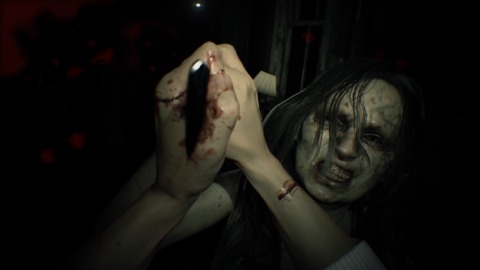
Until Resident Evil 7. I can’t tell you how invigorating it felt when that came out—all the promotional material leading to its release pointed to it being an also-ran Amnesia or PT wannabe, so imagine what a pleasant surprise it was when it turned out to be a classic god-damn Resident Evil game. More so than 4. It wasn’t without its problems, (that last third, oof,) but the first-person perspective of 7 translated surprisingly well to the slower paced, clunky combat of RE1-3, and the emphasis on exploration. Now, the looting involved much cleverer hiding spots, with valuables beneath beds and in dark corners you’d never look at twice in old Resident Evil. Finally, the explicit Texas Chainsaw Massacre and Evil Dead inspirations brought the series back to its long-abandoned B-movie roots.
It wasn’t perfect. But Resident Evil was alive again, dammit.
Then the Resident Evil 2 remake came along and reinvigorated what classic third-person Resident Evil could be again, as well, with the brilliant re-imagination of Mr. X tying into—and I don’t say this lightly—perfect gameplay loop. Of course, Resident Evil 3 remake was a bit of a dud, but not for lack of competence. It was well-made, just pulling from worse source material than 2. So in 3 years, we had 3 back-to-back competent Resident Evil games, and 2 of them were some of the best the series had ever seen.
So, you can imagine my excitement and creeping dread when it was announced that Resident Evil: Village—the next installment in the first-person branch of the series—would take its primary inspiration from Resident Evil 4.
Look, About Resident Evil 4…
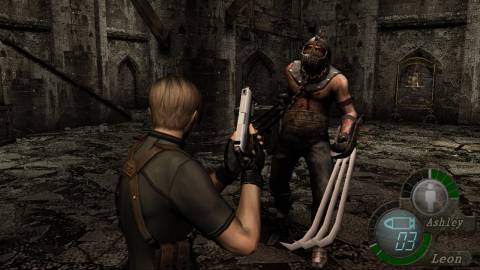
Now, don’t get me wrong, Resident Evil 4 was my introduction to the series as a whole. I love it to pieces. I’ve played it to completion 4 times on the Wii, 3 times on the Xbox 360 re-release, and 3 times on the most recent PC HD remaster. I’ve even considered getting the Switch version. But despite the special place 4 holds in my heart, I had come to acknowledge that it pretty much helped kill the series. That, what made it truly great, despite its action leanings, was how the feel and design of that combat made even a pitched fight with dozens of enemies feel like a scene from a horror film, and no game after managed to strike the same balance. The lack of movement while aiming, the constrained camera, and the premium placed on deliberate placement of shots (aim for the knee or the head, always,) did the impossible and made action still feel tense. Plus, the pacing was just perfectly set to always overwhelm you. And attempting that lightning in a bottle combination of action and horror again with Village? Good fucking luck.
The early footage and demos didn’t help my anxiety, either. The additional focus on combat, while still building on the intentionally clunky foundation of 7—with its emphasis on blocking I never truly got, other than as an acknowledgement of “yeah, you’ll get hit, a lot,”—seemed like a poor fit to me.
And then it came out a few days ago, and here I am, having finished it in two sittings, and with a foot in my mouth, again. Because Resident Evil: Village rules. I have a lot of problems with it, mind you, but it still firmly falls in the “good” Resident Evil camp.
The Story in Like Two Seconds
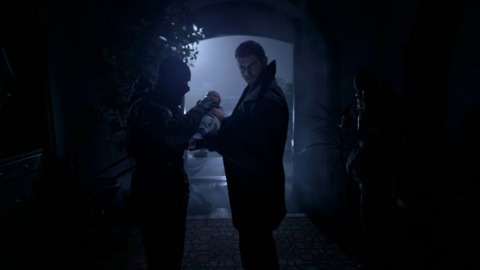
It’s fine. A lot has been made of Chris being a “villain,” which if you have two brain cells or can remember any marketing about a hero being a villain in any game before (coughcough Halo 5 cough), you will know how that turns out.
I do enjoy the characters a lot, especially the goofy bosses of the village. Dr. Moreau might be an all-timer, who just oozes (literally) pathetic energy and pity. A lot has been made of tall-vampire-lady Dimitrescu, and yeah, she chews up the scenery every chance she gets, and it’s wonderful. But on the whole, the story’s just there to get you from tense encounter to tense encounter with as little friction as possible.
SPOILERS:
Resident Evil IV-II
Resident Evil: Village, for better and worse, is an incredibly faithful retread of a lot of the same beats from 4. I would list every beat borrowed from 4, but that might constitute spoilers to some, so I’ll just leave it at this: any time the question is, “how did Resident Evil 4 do it?” Village responds by doing it the same way. There’s very little subversion going on in its most explicit homages. In short, you get in a boat, and hmmm what’s going to happen next? I wonder.
But that’s not necessarily a bad thing. Village, true to its title, really improves on the design of the village and how much there is to do there as you revisit it over the course of the game. In RE4, you retreaded the village twice, and each time it was the same, just with more enemies populated for you to fight. In Village, you’re constantly returning to the village, with new abilities to unlock certain paths, new hazards to face, and new treasure you can find. The map system borrowed whole-cloth from Resident Evil 2—still one of the best maps in video game history—helps facilitate this marriage of the dense level design of old RE, with the linear spectacle of later RE. From the village hub, there are four branches, each to a different boss’ region. Some are totally linear (and are my less favorite,) but a couple are whole new multi-leveled spaces to explore and unlock secrets within over time. It really works, and the classic horror trick of revisiting old areas, only to be shocked by a new threat, works wonders.
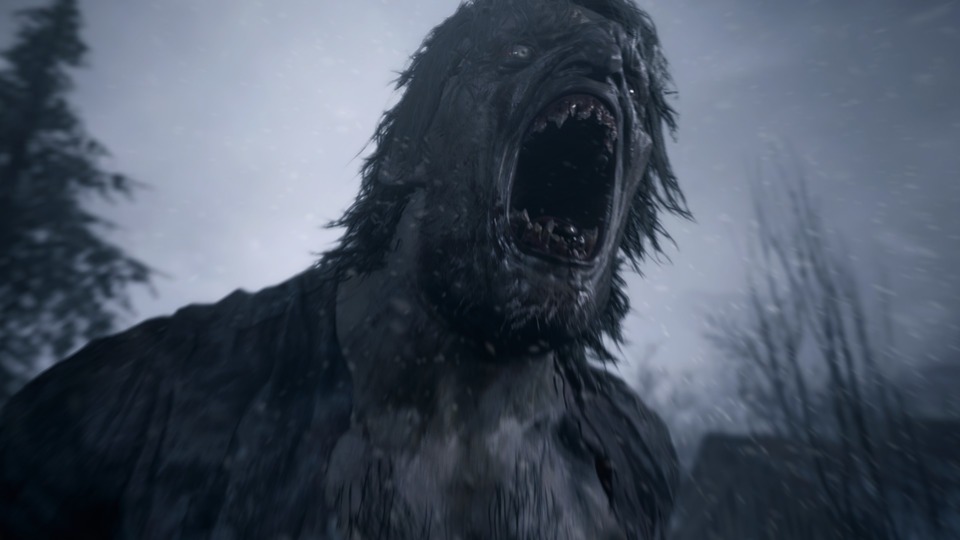
Village also improves on 4 in shockingly specific ways. Back in 4, there were random animals scattered around that you could, for very little reason other than verisimilitude, kill. Chickens would sometime drop eggs, cows would kick you if attacked, fish could be attacked and put in your attache case as a free (if not space efficient) health item. Now, aside from the free health, there wasn’t much use for these animals. In Village, however, a light cooking system has been added, where you can take meat, poultry, or fish, and give these ingredients to the merchant for permanent health, speed, or guarding upgrades. It’s not a big deal, but it was fun having a reason to seek out animals in the environment, especially the rare ones hidden off to the side that can help cook the most valuable meals.
Oh, by the way, you didn’t misread that a couple sentences ago—there’s a merchant in Village. He even says, “What are you buying? An old friend of mine used to say that!” Having a physical merchant is such a welcome return after the menus of 5 and the birdcages of 7, and his character is a bit more involved in the story than I would have initially expected. The Duke, as he’s called, serves as the “objective guy” more often than not, telling your protagonist, “Hmmmm, maybe check out this building?” and then Ethan saying, “Rrrr, I don’t trust you, but OKAY,” and this repeats several times and then the game’s over. That, and the character is just one long-winded fat joke.
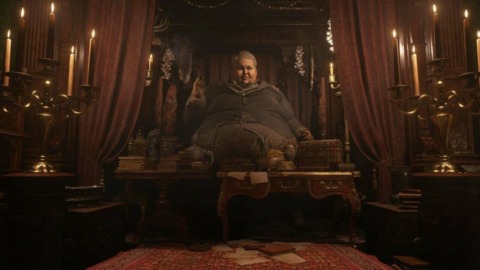
Grousing about the narrative delivery aside, the merchant and upgrades function almost identically to 4. Firepower, rate of fire, reload speed, and ammo capacity can all be upgraded, but like 4, you’ll find yourself not upgrading guns for (warranted) fear of better firearms showing up down the line, making your upgrades, essentially, wasted. You can still do the trick of upgrading ammo capacity when you have 0 bullets in a gun to get free ammo, which I appreciate. (Though tellingly, there’s only one magnum ammo upgrade due to this trick.) Weapons, aside from being upgraded at the merchant, can also have custom upgrade components attached to them which you find in the environment; so, even if you never put a single Lei into them in the shop, when you sell them back to the merchant they’ll have a little more resale value, which is a nice touch. Shockingly, you can buy ammo now, which feels a little sacrilegious, since I was over-replete with ammo for my entire playthrough anyway, so being able to buy more feels excessive.
On a similar disappointing note, the inventory system from 4 returns (yay) but necessary inventory management is non-existent (boo). This is a matter of taste, I suppose, since I know lots of players absolutely despise having to think about inventory space or encumbrance in general, but inventory management is a fundamental aspect of Resident Evil. It’s what drives you to make hard decisions even after every enemy is dead and you’re just looting the world. But, where 4 had this great balancing act of making your inventory feel unbearably cramped for about a chapter or 2, and then releasing that tension with a new inventory upgrade available in the shop, I feel like Village lets up the pressure too early for each inventory upgrade. Don't get me wrong, Village still scratched that itch of making me constantly organize my inventory to make it as pretty as possible, so it did something right; still, I was always in a position of buying new inventory space before I honestly needed it, and then seeing after the fact, “oh yeah, I guess I needed that!” Therefore, I didn’t think of my inventory once while picking items up, leading to a mindless hoovering of everything in the environment. It was certainly a streamlined experience, but was it Resident Evil? Ehhhhhhh…
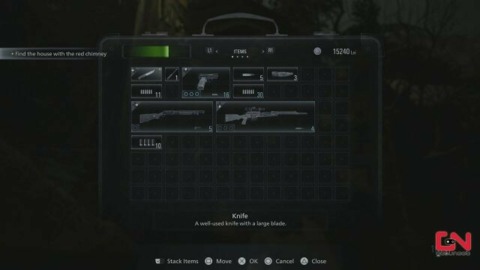
And that’s honestly how I felt about a lot of Village compared to 4, whose shadow looms over every aspect of this entry, from the setting, to the focus on combat, to the upgrade loop. It’s a better game and more intelligently designed, no doubt, and there are an admirable number of quirks from 4 that have carried over for uber-fans like myself. But one too many concessions have been made for me to comfortably prefer it. The ammo situation, on Normal, is too forgiving. The inventory never makes you think. And while there are great moments throughout it, no moment in Village rises to the level of the best of what 4 had to offer. (Though there are some deliciously stupid boss fights near the end that had me cackling and turning to my friends, “are you seeing this?” To which they replied, that, yes, they were seeing this, and it was indeed incredibly stupid. But in a good way.)
The good news, however, is that we are literally comparing Village to one of the best games of all time, even if it’s inviting that comparison, and it’s coming out… okay? So how is it on its own?
Like I said earlier, great!
The Actual Game
In a vacuum, Village would best be described as a survival horror game that, like 7, walks the line between modern horror (Amnesia, run the hell away at all times, you are a powerless infant,) and older survival horror (you can fight, but have to choose your battles). Except, unlike 7, you never really have to worry about ammo on normal, and you can pretty much kill every enemy you encounter with no ammo concerns.
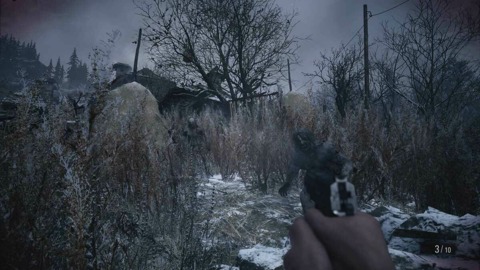
It’s a good thing, then, that the enemy encounters, especially early on, are generally well done. I can’t believe I’m saying this, but I think they’ve decently emulated the combat loop of “shoot enemy in head, stagger them, retreat and turn to shoot again” from 4 in the first person. The guns all feel great, there’s a satisfying head pop effect on critical hits (a must for a quality Resident Evil game), and after a little futzing around, I started to get into the old flow of “stun a guy, knife him, go back to shooting.” With the more precise aiming (especially on mouse and keyboard) afforded by the first person, the design of the game compensates with even more cramped spaces and a general lack of visibility. Fog, darkness, fields of wheat, water, all of these and more will make sure that you don’t have a lot of time to react when an enemy appears, or that you’ll hear them before you see them. It’s a simple, but effective trick.
A couple of grievances with the combat linger, however. For one, a whole game later, I’m still not entirely sure what function block serves in the combat loop. I get it—if the enemy attacks you and you can’t get out of the way, you can block and take less damage. But isn’t that kind of a consolation prize of “hey, here’s the chance to fuck up slightly less?” I never found that fully satisfying, and easy enough to ignore. It wasn’t until a late-game encounter that I discovered you can actually push enemies back when they hit you with an attack, which gives me fuzzy “Leon S. Kennedy roundhouse kick” feelings, and it’s a very welcome crowd control tool, in a game that can honestly use more of them.
Except not? The design of some of the spaces, especially later ones, resort to either throwing a gaggle of enemies at you, or are too forgiving to the point of letting you stand still and headshot three enemies to death before they ever get close to you. So, in theory, I wish there were more crowd control options in this game, but I never really needed them, so…
It’s here that I feel it’s important to say I played the game on Normal, and while I wouldn’t call myself a Resident Evil expert by any means, that was apparently too easy an experience for me to enjoy like a Resident Evil game. I’m planning to replay Village soon on Hardcore, which I’m sure (or hope) addresses a lot of these concerns.
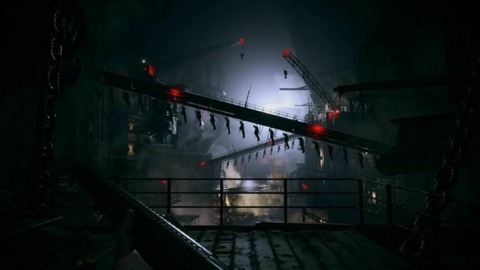
I implied it a little earlier, but this game falls into the same trap that every modern Resident Evil appears to—ending on a really stupidly bombastic note. After, say, the third of four bosses is defeated, the game just starts chucking enemy after enemy at you in an attempt to test your combat prowess, but really just giving you a chance to fling about the disgusting amounts of ammo you’ve hoarded up by that point. There’s nothing as egregious as the boat sequence from 7, but they’re never as engaging as the earlier encounters. Now, there are two moments that are so stupid they come back around to kind of working, but for the most part, I just sort of rolled my eyes and went, “I guess we’re in this part of these games, now.”
A slightly more successful attempt to mix things up is present in some of the game’s unkillable foes. Lady Dimitrescu and her daughters will stalk you through their castle, and those are some effective scenes. I was continually shocked how much the devs were willing to put even Ethan “My Wife Chainsawed my Hand Off” Winters through in terms of body horror in that section, but it works. A similar, if less effective section involves a creepy doll that makes you hallucinate things. You already know what that is. There’s one genuinely unsettling image from that section, but it’s the kind of thing that’s only going to be a pain to replay on subsequent playthroughs. I can see myself now, just sprinting past the creepy monster—“can I get back to the game now?” But it’s fine enough on an initial run.
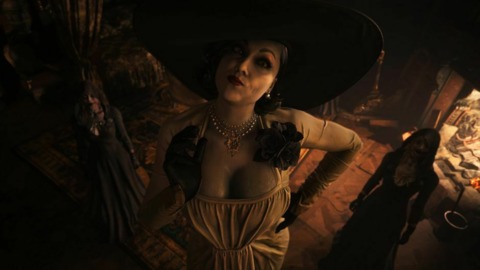
This is also a gorgeous game that runs well. There’s a running joke in my friend group that “snow levels in games are the best levels,” and Village has a snowy mountainside aesthetic I never tired of. Again, things get a little more generic by the end—an industrial setting at the end of a Resident Evil game, wow, so original—but for the most part, it’s a looker. I found the basic enemy design (the Lycan-esque humanoids) to be great, and a lot of the other enemies to be a little lackluster. Here’s a guy in a robe with a sickle. Here’s a naked zombie guy with a sickle. Here’s a buff man with a big axe. Here’s a buff man with a big hammer who has more hair. It’s an improvement on 7’s mold guys, but… not by much.
Despite all these complaints, I really did enjoy my time with Village, and the pacing of it is fantastic. I just didn’t want to put this thing down, to the point of playing for 3 hours starting in the evening when it first unlocked on Steam, to playing the rest of it in one day the day after. The loop of “fight enemies, scavenge an area, use new tools to unlock sections of old areas, return to merchant to upgrade, fight enemies,” just kept me engrossed throughout.
Resident Evil Continues
I remember, after having finished 7, I had a moment of cynicism. I thought to myself, “this is great, but they can only hit the reset button once here.” In other words, bringing the series back to the original—in this case, RE1—can only be done once, and after that, you have to start introducing new things again, and risk making the exact same, or worse mistakes, as you did before. (See here, rebooted Star Trek.) And after finishing 7, I worried that the series wouldn’t maintain its momentum.
So, one new entry later, and here we are. I can say confidently that 7 was not a fluke, and this incarnation of the series is here to stay for some time. I can point to lots of little disappointments that make me, overall, still call 4 my favorite entry in the series, followed closely by Resident Evil 2 Remake, but Village does so much more right than wrong. It gets the pacing right, the tension right, the combat right, and the level design right. In short, it hits the nail on the head in the moment-to-moment experience, which probably contributed to how quickly I played it. And even after finishing it, I want to dive back in.
There were a couple secrets I missed, a few ways I could optimize my upgrade and ammo situation, ways to challenge myself on higher difficulties, and plenty of fun unlocks for new runs. Village has me excited to download it the way I downloaded 4—learn every nook and cranny and play through it blindfolded—and for all my complaints, it’s so nice to feel that again. To feel like this is not only a game I can master, but is worth mastering.
But seriously, you can’t rotate items upside down in the inventory? How the hell can you call this a successor to RE4 without the ability to organize your inventory entirely flipped like an imbecile?

If you read all the way down here, thanks! This one was slightly less holistic/artsy fartsy than my other essays because my impressions of this game are still so recent. I'm looking forward to getting back into Village on higher difficulties and seeing how the new Mercenaries mode stacks up, but if you enjoyed what you read, I have more essays over at my blog, Lapses in Taste.
It's a really recent release, but how have y'all found Resident Evil: Village so far? Expectations exceeded? Met? Undershot? Still miss "old" Resident Evil, whatever that qualifies as in 2021?
